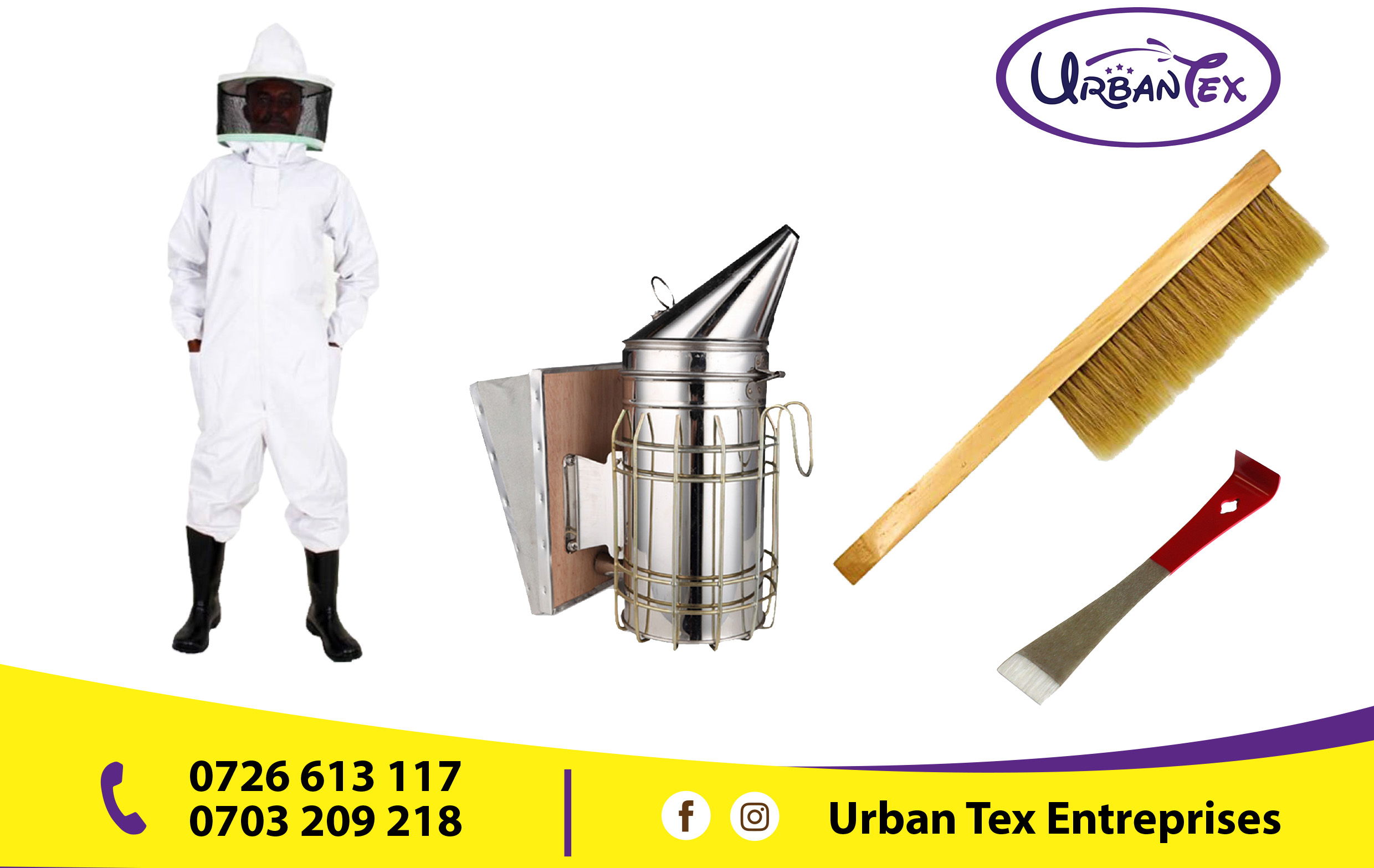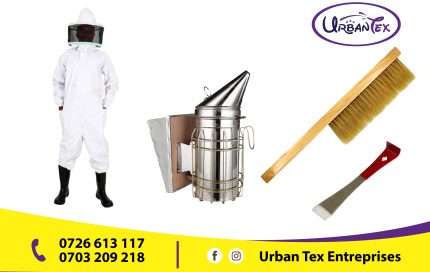- You have no items in your shopping cart
- Subtotal: KSh0.00
You can practice beekeeping at any scale, both as a hobby and for commercial purposes. It requires lower initial costs, and you can always scale up according to your resources, even a hive at a time. Regardless of your approach to beekeeping, you should use the right Beekeeping Equipment for Beekeepers in Kenya to ensure the quality of your honey. Make your work easier and protect yourself or your staff during their work.
Fortunately, beekeepers in Kenya do not need to start with extensive equipment. A few essential items will get you on your way to beekeeping, and as your needs and means grow, you can always purchase the next tool. For starters, however, here are the essential beekeeping equipment for any beekeeper.
What do I need for beekeeping in Kenya?
To successfully embark on your beekeeping journey in Kenya, you will need a variety of essential equipment to ensure both the health of your bees and the efficient production of honey.
Essential Beekeeping Equipment Checklist:
- Beehive: Consider the Langstroth Hive, a popular choice for its ease of use and honey production.
- Beekeeping suit: Protect yourself from stings with a full-body suit and veil.
- Bee smoker: Calm the bees before opening the hive to minimize stress and risk of stings.
- Hive tool: A versatile tool used to pry apart frames, scrape away propolis, and perform various hive maintenance tasks.
- Uncapping fork: Used to remove the wax cappings from honeycomb cells before extracting honey.
- Bee brush: Gently remove bees from frames during honey harvesting.
- Honey extractor: Efficiently extract honey from the combs without damaging them.
- Honey sieve: Filter out wax particles and other debris from the extracted honey.
- Honey settling tank: Allow the honey to settle and clarify before bottling.
Hives Beekeeping Equipment for Beekeepers In Kenya
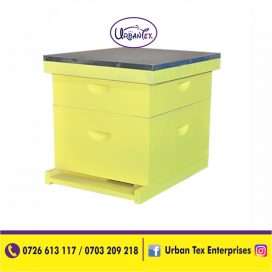
Langstroth Hive
The beehive should be your obvious starting point, its design, however not a straightforward choice. There are different types of beehives, the most common being the top bar bee hive and the Langstroth bee hive.
What is the difference between different types of beehives?
When choosing a beehive, it’s essential to understand the different types available and how their unique features impact your beekeeping experience. Each hive design offers distinct advantages and disadvantages, particularly in terms of construction, maintenance, honey production, and ease of use.
Top Bar Hives: Simplicity and Tradition
The top bar hive, a time-honored design, stands out for its simplicity and affordability. As one of the oldest beehive styles, it features a single-story structure with bars laid across the top. Bees build their comb downward from these bars, making it easier for beekeepers to inspect and harvest honey without disturbing the entire colony.
Pros:
- Simple Construction: Top bar hives are relatively easy to build and require minimal materials, making them a budget-friendly option.
- Easy Inspection: Beekeepers can easily lift individual bars to inspect the comb, minimizing disruption to the bees.
- No Heavy Lifting: Since there are no stacked boxes, harvesting honey doesn’t involve heavy lifting.
Cons:
- Maintenance: Top bar hives may require more frequent maintenance to prevent comb attachment to the hive walls.
- Lower Honey Yield: Compared to other hive types, top bar hives typically produce less honey.
- Limited Expansion: The single-story design limits the hive’s capacity and potential for honey production.
Langstroth Hives: Modern Efficiency and Productivity
The Langstroth hive, a more modern design, is the most widely used beehive worldwide. It consists of stacked boxes with removable frames, allowing for easy expansion and honey harvesting. This modular design makes it a favorite among both hobbyist and commercial beekeepers.
Pros:
- Higher Honey Yield: Langstroth hives offer greater honey production potential due to their expandable design.
- Easy Expansion: Beekeepers can add more boxes as the colony grows, maximizing honey production.
- Less Maintenance: The removable frames make it easier to manage the hive and prevent comb attachment issues.
- Versatile Extraction: Langstroth hives are compatible with various honey extraction methods.
Cons:
- Complex Construction: The multi-box design can be more challenging to build than a top bar hive.
- Heavy Lifting: Honey supers can become quite heavy when filled with honey, requiring careful lifting.
- Higher Cost: Langstroth hives may be more expensive than top bar hives due to their complex construction and additional components.

Beekeeping Suit
Your beekeeping suit isn’t just an outfit; it’s your first line of defense against bee stings. A good bee suit provides head-to-toe protection, shielding you from the ankles up to the crown of your head. The most important feature is the veil, a mesh hood that covers your face and neck, preventing bees from reaching your most vulnerable areas.
When choosing a bee suit, prioritize durability and sting resistance. Look for materials that are thick enough to withstand bee stings and woven tightly enough to eliminate any gaps where bees could crawl through. However, comfort is equally important, so ensure your suit offers adequate ventilation and visibility to keep you cool and comfortable while you work.
Beyond the suit itself, consider additional protective gear such as beekeeping gloves and sturdy boots. Gloves protect your hands from stings, while boots provide ankle support and prevent bees from crawling up your legs.
By investing in a quality bee suit and protective gear, you’ll gain the confidence to work safely and comfortably around your bees, allowing you to focus on the rewarding aspects of beekeeping without the worry of stings. Remember, your safety is paramount, and a well-equipped beekeeper is a successful beekeeper.
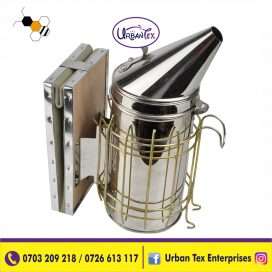
Bee Smoker
The bee smoker is an ingenious device emits a gentle, controlled stream of smoke that triggers a fascinating response in bees. The smoke masks alarm pheromones, causing the bees to focus on eating honey in preparation for a potential evacuation. This creates a window of opportunity for you to safely inspect and work within the hive, minimizing disruption and the risk of stings.
When selecting a bee smoker, opt for one with a heat shield to protect your hands from accidental burns. Stainless steel models are a great choice, as they’re durable, easy to clean, and resistant to corrosion.
Investing in a quality bee smoker not only makes your beekeeping experience more enjoyable but also promotes the well-being of your bees by reducing stress and potential harm during hive inspections.
Hive Tool
A hive tool is like a bee keeper’s swiss knife, and it is an essential part of beekeeping. Bees are excellent, and sealing and gluing stuff together, makes it hard to move anything. The hive tool helps you remove the frames from the hive, detach the honeycomb from the sides, pry loose the frames, and even scrap and cut the propolis. It is an essential tool during both hive inspection and honey harvesting.
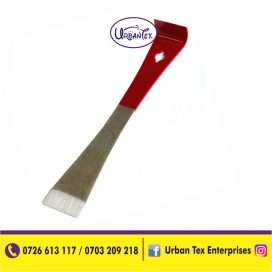
Uncapping Fork
An uncapping fork is a tool that helps you remove the honey from the comb without affecting the comb’s integrity. The comb is left in place on the frame, so the bees do not have to build a new comb. It is also called the uncapping tool and looks like a lend of a brush and a fork.
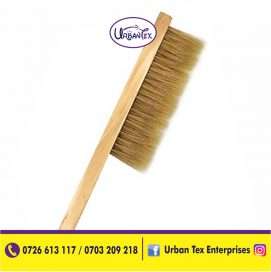
Bee Brush
The bee brush is a simple tool that aids inspection and honey harvesting. It helps you move bees from the spot you are working on or where they should not be, like in the case of correcting swarming. Its design allows you to move the bees without hurting or agitating them. Pick a simple brush with natural bristles.
3 Frame Stainless Steel Centrifugal Honey Extractor
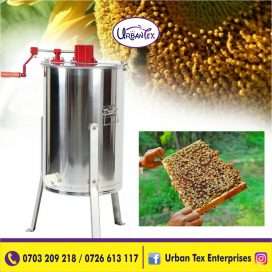
A honey extractor is a modern way of getting honey from honeycombs. Traditional options would be to crush the honeycombs or to uncap the honeycombs and let the honey drip out slowly. A 3 frame centrifuge honey extractor ensures you get the honey out more efficiently. It uses centrifugal force to get the honey down faster than how gravity would do. It also keeps the combs safe so that the bees can reuse them. Invest in an excellent extractor like the 3 frame stainless steel honey extractor, and you will get higher honey yields.
Honey Sieves
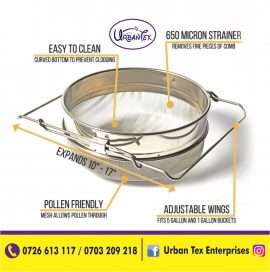
A honey sieve or a honey strainer does what the name suggests; it sieves honey, removing the impurities from the honey that come from the extraction process. The best honey should be free from pollen, wax, and other debris. There are different kinds of honey sieves, with the most popular ones including the stainless steel double sieve and the conical sleeve. The right honey sieve will also ensure you have honey with an even and smooth consistency.
Honey Settling Tank
Once you have your honey extracted and filtered, you need to store it in a container before bottling it. The container is the honey settling tank which allows air trapped in the honey to escape before you bottle the honey. Honey also needs to settle for about 12 to 24 hours to allow further separation from any present impurities. The honey settling tank is made using food-grade plastic or food-grade stainless steel. They come in different sizes. You have the option to pick one that best serves your need.
Where to find Beekeeping Equipment in Kenya
Equipping yourself with the right tools is the key to a successful and enjoyable beekeeping journey. Remember, your beekeeping equipment is an investment in the health of your bees and the quality of your honey harvest.
Don’t settle for less than the best! At Urban Tex Enterprises, we offer a comprehensive range of high-quality, affordable beekeeping equipment tailored to the unique needs of Kenyan beekeepers. Our experienced team is passionate about beekeeping and dedicated to helping you find the perfect tools to suit your specific goals and budget.
Why choose Urban Tex Enterprises for Beekeeping Equipment?
- One-Stop Shop: We have everything you need under one roof, from hives and protective gear to honey extractors and processing tools.
- Quality Assurance: Our products are made from durable, food-safe materials, ensuring the safety of your bees and the purity of your honey.
- Competitive Pricing: We offer the most competitive prices in the market, without compromising on quality.
- Expert Advice: Our knowledgeable team is always ready to answer your questions and guide you towards the right equipment choices.
Ready to get started? Visit our online store at to explore our wide selection of beekeeping equipment or visit our physical store at: Nairobi CBD, Munyu Road Business Centre, 3rd Floor Room D2.
Let Urban Tex Enterprises be your partner in beekeeping success.
Call us today at 0726613117 or 0703209218 and experience the difference of quality equipment and expert support.
The Best Beekeeping Equipment for Beekeepers in Kenya.

